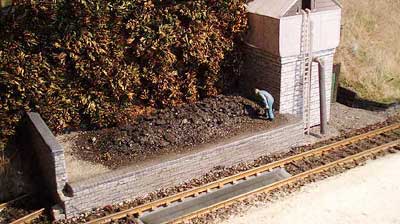With only photographs of the bridge to hand the challenge is to accurately determine dimensions of it. First stop was the satellite image on Google maps and using the scale measure provided I estimated the length of a side to be 150 feet, that's 600 mm in 4 mm scale and since the sides are skewed the model is going to be huge. Next, I needed to work out its height and radius of the curved top.
My photo of the north side was opened in Photoshop and scaled by reference to the brick pillars and a standard brick size and as a check measured the length for comparison with the previously determined 600 mm. It was 601.5 mm - good enough.Railway modelling is a craft that fuels the creative needs of the soul. This is a journal about my railway modelling activities.
About Comments
Sunday 28 April 2024
Project 24 - Battledown Flyover #2 (design approach)
Sunday 21 April 2024
Project 24 - Battledown Flyover #1 (preamble)
Having successfully completed my first Resin 3D print project I was considering what to create next. The thing about Resin 3D printing is its ability to produce miniscule, crisp details. This drives us to go the extra mile in model design. In particular, as far as railways are concerned - rivets. Yes, I have become a rivet counter!
Within walking distance of my home is Battledown Flyover - The Gateway to the West. It carries the up line from Southampton whilst the Salisbury up & down lines pass underneath, at a slew.
 |
| Battledown Flyover by Sandy B, CC BY-SA 2.0, via Wikimedia Commons |
If I modelled this scene where could I put it? My railway room is overflowing with layouts.
Wednesday 10 April 2024
Ballast Cleaning Train - Part 19 (SLA Resin 3d Print Version)
This is the final part for this project.
 |
| How they were coupled for travelling. In operation the generator was coupled to the other end of the machine and an electrical cable connected between them. |
Read about the SLA (stereolithography) resin 3D printer here.
Read about the FDM 3D printed version and its train here.
Movie below features the FDM 3D printed model and its train.
Sunday 7 April 2024
Ballast Cleaning Train - Part 18 (SLA Resin 3d Print Version)
Why black for wagons that are to be finished in 1960s departmental yellow? Black is a common base for figurine painting as it enhances shadows caused by creases in clothing when overpainted to let the black through in places. The same principal is applied here except there is so little relief in these parts that shadows are minimal. Furthermore, I found that it changed the hue of the final yellow coating requiring multiple layers to recover. I will not use black for the remaining parts of this build. However, it was useful in simulating the rubber surround of the window panes that were revealed when the masking tape was removed.
It was really difficult to emulate the yellow colour of the prototype. The Railmatch 2304 I chose was far too yellow. My first approach was to tone it down with a white wash. This made it too pale so I followed up with a brown wash that brought it as close to prototype as I could achieve.- No visible print layers
- Finer details e.g. axle boxes and leaf springs fully formed - as good as injection moulded. (For the FDM model I butchered a proprietary wagon and implanted its injection moulded axle box and leaf springs to achieve detail.)
- Sharper corners and edges
- Fewer parts
Wednesday 3 April 2024
Ballast Cleaning Train - Part 17 (SLA Resin 3d Print Version)
Spent some time viewing tutorials on weathering to learn a method for the two chassis.
First stage was grey primer even though one recommendation was not to bother because the plastic base will take acrylic paints and the more layers of paint that are applied the more the definition of fine details will be lost.













